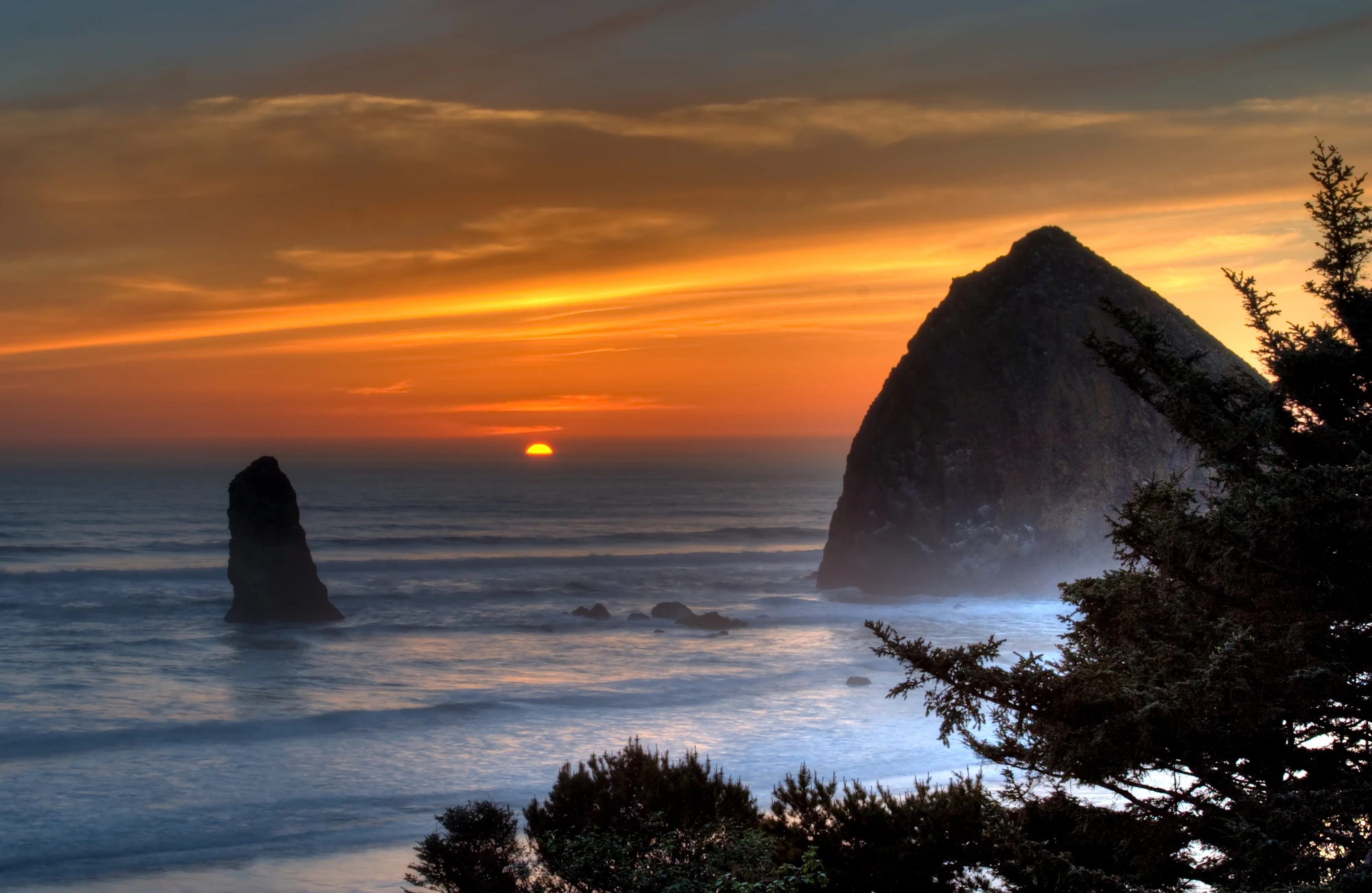High Tide and Sea Stacks: Sunset at Cannon Beach
A photographer’s paradise and a tidepool classroom — where basalt towers meet the Pacific.
Photo by Anderl
Shutterstock (ID: 55049032)
The first time light finds Haystack Rock, it takes its time — a slow, deliberate burn across the wet sand that turns the basalt monolith into a lantern you can walk toward. At Golden Hour the ocean becomes a long, shifting mirror, the tide inching like a thoughtful animal toward the base of the sea stacks. Standing on Cannon Beach with a cool wind carving patterns in your hair, the place feels engineered to hold your attention: a perfect foreground for the Pacific’s unhurried drama.
Trail Wisdom
Time your tide visit
Plan tidepooling for 1–2 hours around low tide and always check the local tide chart before heading out.
Dress for wind and spray
Layer a breathable windproof jacket over insulating mid-layers — conditions can shift from sun to drizzle quickly.
Protect the wildlife
Stay behind roped areas at Haystack Rock and avoid disturbing nesting birds or tidepool organisms.
Watch for sneaker waves
Never turn your back on the ocean; larger waves can appear unexpectedly and sweep across the sand.
Local Knowledge
Hidden Gems
- •The Ecola Head Trail viewpoint for broad coastal panoramas
- •Tolovana Park and quieter west-facing coves for less crowded sunsets
Wildlife
gray whales (on seasonal migration), harbor seals and seabird colonies
Conservation Note
Haystack Rock Marine Garden is protected and managed to preserve tidepool habitats and nesting seabirds; visitors are asked to observe closures and Leave No Trace practices.
Cannon Beach developed as an artists’ colony in the early 20th century and gained pop-cultural fame when nearby locations were used in the film The Goonies.
Seasonal Guide
spring
Best for: birdwatching, wildflower viewing, tidepool life
Challenges: cooler temperatures, variable rain and wind
Spring brings migrating birds and an active intertidal zone; pack layers and expect occasional storms and brisk winds.
summer
Best for: calmer seas, long daylight, family beach days
Challenges: larger crowds, limited parking
Summer offers the most stable weather and pleasant sea conditions, but arrive early to beat crowds and secure parking.
fall
Best for: photography, whale watching, fewer crowds
Challenges: shorter days, cooler evenings
Early fall is arguably ideal — warm lingering weather, clear light for photography, and thinning visitor numbers.
winter
Best for: storm watching, dramatic skies, solitude
Challenges: cold, wet conditions, strong winds and high surf
Winter delivers dramatic ocean moods; come prepared with heavy layers and respect surf advisories.
Photographer's Notes
What to Bring
Waterproof hiking shoes or neoprene bootiesEssential
Keeps feet warm and provides traction on wet sand and slick tidepool rocks.
Windproof rain jacketEssential
Shields you from coastal spray and sudden squalls while staying breathable.
Wide-angle camera lens and polarizer
A wide lens captures sea stacks and sweeping beach vistas; a polarizer reduces glare and deepens skies.
Tide chart app or printed tide tableEssential
Knowing low and high tides is essential for safe and productive tidepooling and beach planning.
Common Questions
When is the best time to visit Haystack Rock?
Low tide during early morning or late afternoon offers the best tidepool access and softer side-light for photos; check local tide charts for exact times.
Can you climb Haystack Rock?
No — Haystack Rock is a protected Marine Garden and bird sanctuary; climbing is prohibited to protect nesting birds and fragile tidepool life.
Are dogs allowed on Cannon Beach?
Dogs are allowed on much of Cannon Beach but must be leashed or under voice control per local ordinances; avoid bird nesting areas and check seasonal restrictions.
Is parking difficult at Cannon Beach?
Parking at the main beach and Haystack Rock can fill quickly on summer weekends; arrive early or use nearby lots and be prepared to walk a short distance.
Are there guided tours for wildlife viewing?
Yes — local outfitters and state park ranger programs offer guided tidepool walks, birding tours, and kayak trips for marine wildlife viewing.
What safety hazards should I be aware of?
Watch for sneaker waves, slippery rocks, and rising tides; stay off wet, algae-covered surfaces and never turn your back on the ocean.
What to Pack
Waterproof shoes for traction on wet rocks; windproof jacket for coastal spray and gusts; tide chart or app to plan low-tide exploration; camera with wide-angle lens to capture sea stacks and reflective sand.
Did You Know
Haystack Rock is approximately 235 feet (72 meters) tall and is part of a designated Marine Garden that protects intertidal organisms and nesting seabirds.
Quick Travel Tips
Arrive early to secure parking; check tide charts before exploring tidepools; bring layered clothing for wind and spray; respect roped-off bird nesting areas.
Local Flavor
Cannon Beach blends seaside dining with a thriving arts scene — sample local Dungeness crab or clam chowder, stroll independent galleries, and pick up handcrafted souvenirs from coastal artisans.
Logistics Snapshot
Nearest town: Cannon Beach, OR. Parking: limited at peak times; arrive early. Tides: consult local charts. Facilities: restrooms and shops near the main beach; limited services in shoulder seasons.
Sustainability Note
Support protected habitats by staying on marked trails, observing bird closures at Haystack Rock, packing out all trash, and avoiding collecting shells or marine life.

